#Himalayan Glaciers
Text

Mahesh Magar, a guide with Himalayan Research Expeditions, exits a cave on the Khumbu Glacier, just a short walk from Everest Base Camp. With elevations of more than 17,500 feet above sea level, these are some of the highest mapped caves in the world. Caves like this one are forming in high altitude Himalayan glaciers as soaring temperatures send more meltwater cascading through the insides of glaciers, melting tunnels that are literally rotting glaciers from the inside out.
These Caves Mean Death For Himalayan Glaciers
Otherworldly Ice Caves are Rotting the Glaciers From the Inside Out, Putting Villages Below in the Path of Devastating Potential Flash Floods.
— By Douglas Fox | Photographs By Jason Gulley | January 10, 2024
Jason Gulley has spent 19 years crawling through the insides of glaciers, from Alaska to Nepal. Sometimes these caves, carved through the ice by running water, are large enough for a truck to drive through. Other times, they’re so narrow that he slides along the slippery floor on his belly. If he pauses, his clothing can freeze to the ice.
Gulley is a geologist at the University of South Florida, who began his career studying limestone caverns. It was only by chance that he started exploring the insides of glaciers. The first time he entered one of these caves in the Mount Everest Region, on Lhotse Glacier, was a harrowing experience.
He and his companion stood outside the entrance, watching basketball-sized rocks rain down from the unstable ice cliff overhead. After gathering his wits, he sprinted inside—followed a moment later by Douglas Benn, a veteran Himalayan Glaciologist from the University of St. Andrews in Scotland.
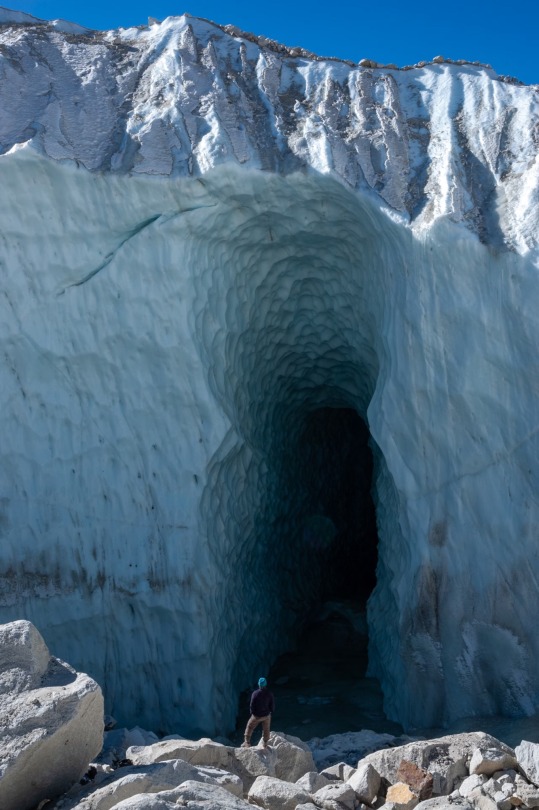
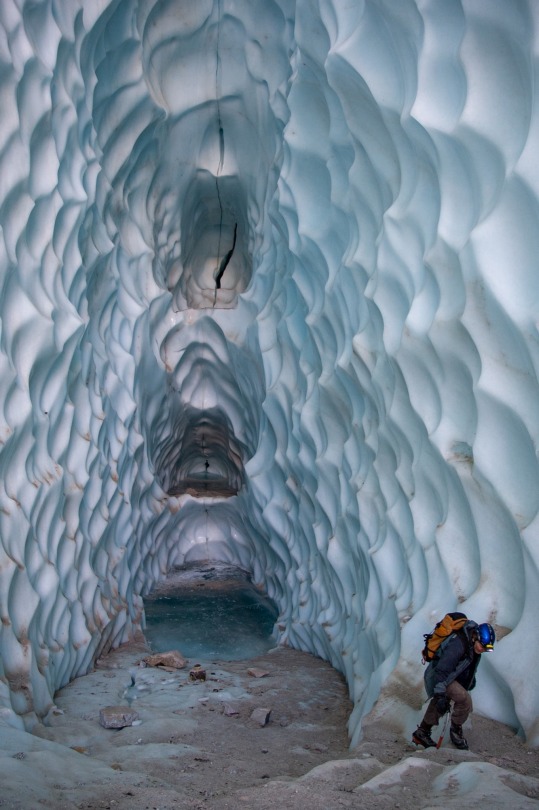
Left: Glaciologist Doug Benn enters a massive cave on the Khumbu Glacier in December 2006. This cave formed as ponds of melted water, sitting on top of glaciers, elevated water pressured and punched open the cracks, causing lake water to surge into the surrounding ice. Right: As the mountainous region warms, these ponds of melted water are becoming more common, hastening the demise of frozen glaciers.
After a few minutes in the cave, they accidentally triggered a minor collapse. The brittle ceiling shattered in a rain of ice shards. “That’s when it really started to dawn on us,” says Gulley. “We really have no idea of what could kill us in here.”
In the years since, Gulley, Benn, and several other scientists have managed to explore these little-known caves. Their work has laid bare the private lives of glaciers—and the disease that is rapidly consuming them.
Glaciers in the Himalaya are thinning by up to nine feet per year, and these caves are playing a pivotal role, hollowing out and collapsing the ice from within.
“It’s the cancer that’s eating what’s left of the glacier,” says Gulley.
As the world warms, the tongues of these glaciers are melting into large lakes, which threaten to unleash flash floods upon villages in the valleys below.
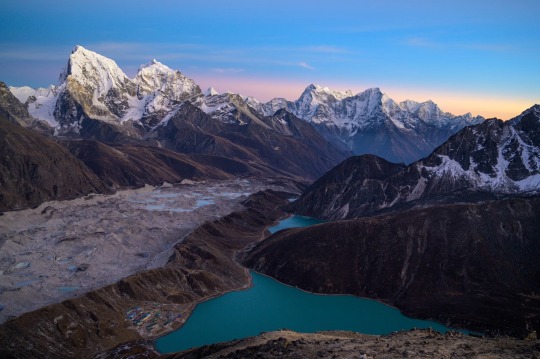
The Sherpa settlement of Gokyo lies beneath the rapidly disappearing Ngozumpa Glacier. Like nearly half of the glaciers in Nepal's Everest Region, the Ngozumpa Glacier is covered in rocky debris shed by adjacent mountains.
Little-explored Caves
Glaciers in the Himalaya differ from what most people imagine. Stand at the lower end of Ngozumpa Glacier, which flows from 26,864-foot Cho Oyu, the world’s sixth-highest mountain, and you will see what appears to be a jumble of rocks filling the valley.
Ngozumpa, like many Himalayan glaciers, is fed by avalanches that sweep down from above—depositing snow, rocks, and boulders onto its upper reaches.
As the glacier descends into warmer air, its surface starts to melt. This removes the upper layers of ice, bringing the buried rubble back to surface. There it accumulates in a layer, up to four feet thick, covering the glacier.
Many Himalayan glaciers are “debris-covered,” like Ngozumpa, and scientists believed that this would insulate them from warming temperatures. But it hasn’t worked out that way, says Teiji Watanabe, a geomorphologist at Hokkaido University in Japan, who has frequently visited the Everest Region since the late 1980s.
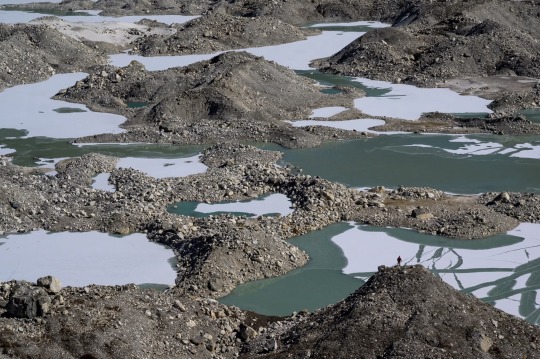
Melting water forms pools on the debris-covered Ngozumpa Glacier, in the Everest region of Nepal. Lakes like these heat up during summer and provide large sources of relatively warm water that can carve cave passages into the ice by melting the layers of ice below.
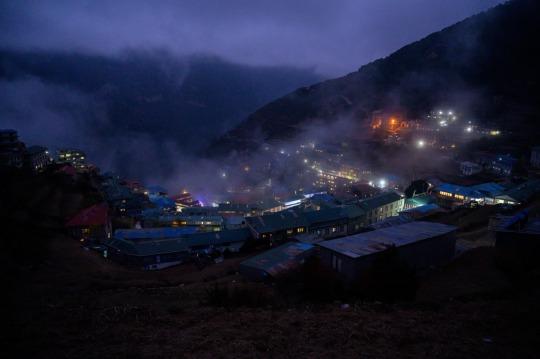
Electric lights in the Sherpa capitol of Namche Bazaar light up the night sky. Namche Bazaar and other nearby Sherpa settlements receive electricity from a small hydroelectric power plant. Infrastructure like this is vulnerable to floods from overlowing glacier lakes.
In the past few decades, the surface of Ngozumpa and other debris-covered glaciers has become pocked with thousands of sinkholes up to 100 feet deep, as the ice shrinks beneath the rocks. Melt ponds frequently fill these depressions. The total area of these ponds has tripled in 30 years—a rate of change that “is really, really amazing,” says Watanabe.
The cause of that rapid change was a mystery. But around the year 2000 Benn, the Scottish glaciologist, noticed a clue.
Melt ponds on Ngozumpa and other debris-covered glaciers often disappeared overnight. At the bottom of these empty depressions, Benn found cave openings, through which the lake had drained.
No one knew how extensive those caves were, or where they went.
But in 2004, Benn met Gulley—an accomplished caver—through a mutual friend.
Benn’s photos of gaping cave openings and pitted glaciers reminded Gulley of limestone landscapes in the Caribbean, where thousands of sinkholes had formed as caves collapsed beneath the surface. With Gulley’s expertise, they entered their first glacier cave in the Everest Region, in 2005.
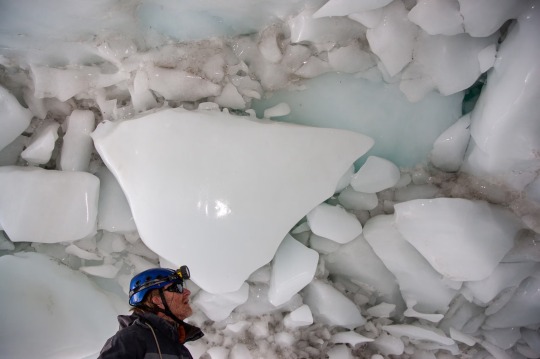
Glaciologist Doug Benn examines the roof of a glacier cave on Nepal's Khumbu Glacier. The entire cave roof consists of blocks of shattered ice that had been frozen together.
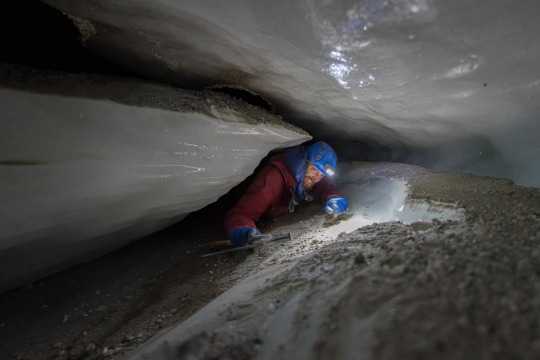
Glacier researcher Matt Covington moves through a tight section of a cave inside the Ngozumpa Glacier, during a 2018 expedition. Crawling at altitudes between 15,000 and 18,000 feet above sea level is one of the most physically demanding parts of cave exploration.
A Downward Spiral of Melting Caves
As they ventured into the darkness, the beams from their headlamps illuminated the fog of their breath. Thin layers of dust, as fine as flour, coated the surfaces — “as if the cave was a store that went out of business 30 years ago,” says Gulley.
They hurried out of that first cave after part of its ceiling collapsed.
Their second cave entry, several days later, didn’t go much better. As they walked down a passage, their spiked crampons crackling on the ice, Gulley suddenly plunged through the floor.
Only later did they realize they’d been walking on a false floor—a veneer of ice, three quarters of an inch thick, that had formed on top of standing water. That water later drained out from below—leaving the five-foot void that Gulley fell into.
They gradually learned to avoid these hazards. And as they explored Ngozumpa Glacier, year after year, Gulley was amazed at how these meandering ice caves resembled limestone caverns—except in the glacier, the ornate scallops, grooves, stalagmites, and stalactites had formed in a few months, rather than thousands of years.
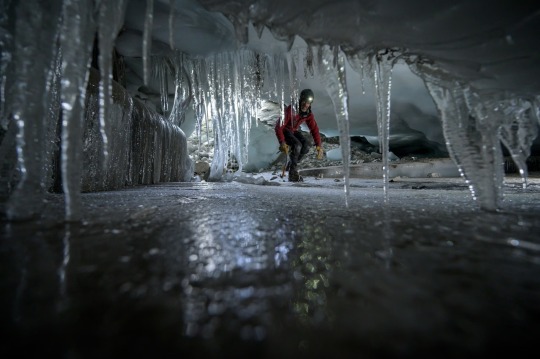
Jason Gulley navigates a cave in Nepal's Ngozumpa Glacier, stooping as he walks. Even experienced cave explorers struggle to descend caves covered in ice.
The caves formed where bands of debris-rich ice provided a weak spot that melt water exploited. The passages were often round, with a deep chasm cutting into the floor, indicating it was carved by gushing water that eventually slowed to a stream.
But glacier caves also differed in some striking ways.
As Gulley and Benn made repeated trips to Ngozumpa Glacier, they saw that narrow passages often squeezed shut from one year to the next—the glacial ice oozing inward like silly putty. Those passages melted open again the next time water from a draining lake gushed through.
These observations led Benn and Gulley to a theory—published in 2017—of how caves erode debris-covered glaciers.
“As those caves expand and collapse, they’re creating new depressions, that create new lakes, that create new caves,” says Gulley.
As this downward spiral continues, the depressions expand and deepen, forming ice cliffs that melt quickly because they’re warmed by sunlight. Warm melt ponds undercut the ice cliffs—crumbling them—exposing more bare ice.
In this way, a depression “can grow faster and faster the bigger it gets,” says Ryan Strickland, a PhD student studying caves at the University of Arkansas.
Strickland used a drone to measure 3,000 depressions on Ngozumpa Glacier. His analysis, published in August, suggests that depressions really do grow more quickly as they expand—consistent with Gulley’s theory that melt caves drive the process.
“It’s absolutely plausible,” says Owen King, a mountain glaciologist at Newcastle University in the United Kingdom, who has worked in this region. “The mechanisms that Ryan has described, we can definitely see evidence for.”
The melt water gushing through caves gathers in a massive lake near the glacier’s terminus. Spillway Lake is half a mile long. It is dammed by a massive ridge of rubble that the glacier piled up over thousands of years. As it grows, it could rupture that dam, sending several million cubic yards of water plunging down the valley.
In 1985, a glacial lake outburst flood eight miles southwest of Ngozumpa swept away 14 bridges, 30 houses, and a hydroelectric plant. This flood risk will increase as more glaciers give way to lakes.

Mere steps from Everest Base Camp, a pair of researchers drop into a glacier cave on Nepal's Khumbu glacier. Rising temperatures and melting ice lowered the ice surface at Everest Base Camp by a staggering 98 feet between 1984 and 2015.
A Remnant Cave Left High and Dry
When Gulley visited Ngozumpa Glacier in 2018 and 2019, he was shocked by what he saw. Very few caves remained. So much of the glacier had sagged down to the level of Spillway Lake, that melt water was no longer driven to flow downhill and create new caves.
They did find one fragment of a cave that Gulley first mapped in 2005. Back then its entrance was at the bottom of a depression. But now all that remained was a short section of cave piercing a ridge of ice.
Even as melt caves disappear from the lower reaches of Ngozumpa, they will penetrate higher up the glacier’s 22-mile length. Melt caves will eviscerate more and more glaciers—creating lakes that could release devastating floods.
“These caves are symptoms of dying glaciers,” says Gulley. “This is what almost all of the glaciers in the Everest Region are going to be turning into.”
1 note
·
View note
Text
The changes in precipitation are evident on the mountains of the Himalayan state of Uttarakhand, says Bikram Singh, head of the regional weather office. "We can definitely say snowfall frequency has decreased and this is usually at elevations below 6,000m. During monsoon, the lower elevations receive heavy rainfall." The dwindling snowfall and increased rainfall mean that the nature of rivers in the region has changed, says Professor JS Rawat, former head of Kumaun University's geography department. "There are now lots of flash floods after extreme rainfall and rivers that were once glacier-fed in the region have now turned into rain-fed [water bodies]." Rising temperatures have added to the problem as they have accelerated the melting of Himalayan glaciers. This leads to rapid filling up of glacial lakes that then become prone to overflowing and causing floods. The thinning of glaciers also destabilises mountain slopes.
Navin Singh Khadka, ‘Himachal Pradesh floods: More rain, less snow are turning Himalayas dangerous’, BBC
1 note
·
View note
Text
""At the current pace of warming, up to 70 percent of Himalayan glaciers could be lost this century. Cutting particulate pollution in South Asia, they said, could help preserve what snow and ice remain." Yale Environment 360
#Yale University#Yale Environment 360#Yale Climate Communications#Himalayan Snowpack#Climate Change#Particulate Pollution#Himalayan Glaciers#Yale E360
0 notes
Text

Dhaulagiri mountain, Nepal.
The name comes from Sanskrit where धवल (dhawala) means dazzling, white, beautiful[3] and गिरि (giri) means mountain.
https://commons.wikimedia.org/wiki/User:Solundir
#dhaulagiri#nepal#himalayas#himalayan#mountain#mountains#alpine#sanskrit#nepali#asia#south asia#sky#snow#glacier#buddhism#heavenly#sherpa#landscape#wiki#wikimedia commons#wikipedia#photo#photography#berge#mountain peak#mountain climbing#geography#mountaineering#nature#trekking in nepal
6 notes
·
View notes
Text
do u guys ever go to stores and test/sniff the scented stuff (like body wash, perfume, deodorant, etc.) to figure out which ones ur ocs use
#bc I do#idk which cologne he uses yet but isao uses the old spice gentleman’s deodorant and body wash#the Himalayan sea salt and glacier water ones#xerxes also uses the old spice gentleman’s but the vanilla and cinnamon one#i don’t remember which cologne i picked out for him i need to go back to ulta#nonsims
5 notes
·
View notes
Text
Me: *shopping for deodorant*
Me: hm. this one smells like my dad who stopped talking to me when I was seventeen
Me:
Me: It’s probably weird to buy this one then
#Old Spice gentleman’s collection. Himalayan Sea Salt & Glacier Water Scent.#it isn’t the actual deodorant that he used but still smells like him.#go ahead. sniff my dad. whatever. I’m gonna chase this loud ass bird off my neighbour’s lawn#blog tags:#turtle talks a lot
0 notes
Text
264 notes
·
View notes
Text
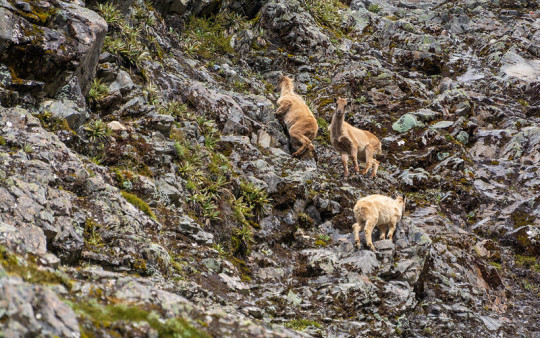
A group of Himalayan tahr (Hemitragus jemlahicus) near Cameron Glacier, Canterbury, Aotearoa.
by Jake Osborne
#himalayan tahr#bovines#hemitragus jemlahicus#hemitragus#bovidae#artiodactyla#mammalia#chordata#wildlife: aotearoa#wildlife: oceania#invasive species
65 notes
·
View notes
Text
"As an environmentalist, I am very concerned about the fragile and sensitive ecosystem of Ladakh,” said Magsaysay Award-winning educationist Sonam Wangchuk, who recently concluded his 21-day hunger strike in Leh. Popularly known as 'climate fast', Wangchuk had begun observing it on 6 March, demanding constitutional safeguards for Ladakh.
On the final day of his fast on 26 March, Wangchuk said that the people of Ladakh are trying to awaken the conscience of Prime Minister Narendra Modi and Home Minister Amit Shah so that they take suitable action to safeguard the fragile ecosystem of Himalayan mountains in Ladakh and preserve the unique indigenous tribal culture.
“We don’t like to think of Modi ji and Amit Shah ji as just politicians, we would rather think of them as statesmen but for that, they will have to show some character and farsightedness…” he posted on X.
Wangchuk had become the face of a sustained agitation in the cold desert where people are up in arms against the central government for discarding their concerns regarding land and job rights.
"Every drop of water is important here. Ladakh can't support large numbers. It will make refugees out of locals and even for those who arrive, the situation would not be any good. That's the fear people have regarding the fate of our land and our culture – finely tuned over tens or even thousands of years to survive in these mountains, now at risk of dilution and unable to sustain itself,” he added.
However, this was not the first time that Wangchuk had undertaken a climate fast:
In January 2023, he undertook a five-day climate fast at his institution, the Himalayan Institute of Alternatives (HIAL) in Ladakh at -20 degrees Celsius.
In June 2023, Wangchuk again went on a nine-day climate fast to save "Ladakh’s fragile ecology."
The Ecological Connection to Ladakh’s Demands
Ladakh is a high-altitude desert inhabited by around 3 lakh people. The region is considered ecologically fragile due to its extreme climate conditions, scarce vegetation, and limited water resources. Most people are dependent on agriculture as a means of livelihood.
A separate territory was a long-pending demand of the Ladakhis but they were expecting one with constitutional safeguards – somethingthat was categorically denied by the Bharatiya Janata Party (BJP)-led government earlier this month.
Their land and job rights were taken away with the Abrogation of Article 370 on 5 August 2019, and the region was thrown open to people from other states.
Sensing that New Delhi is not in any mood to extend the Sixth Schedule that would safeguard the region and grant limited autonomy to the tribal region, the engineer-turned-educational reformer had announced a "climate fast” back in 2023 in a bid to turn attention towards the region's delicate ecology.
Speaking to The Quint, Wangchuk said that global warming has been melting glaciers in the Himalayan region where Ladakh is located. He also added that shifting weather patterns are resulting in frequent flash floods, landslides, and droughts that are impacting the lives of people living in the sparsely populated villages of the region.
"We are protesting to safeguard the mountains of the Himalayan region from indiscriminate exploitation and mining which have already wreaked havoc in places like Uttarakhand, Himachal Pradesh, and even Sikkim. All these activities are now poised to impact Ladakh,” he added.
Wangchuk’s Relentless Efforts To Save Ladakh: The ‘Third Pole’ of the Planet
Lately, the glaciers are receding fast and many sectors in Northern India rely on them.
Wangchuk said that Ladakh, which is home to an extensive glacial system, is known as the "Third pole of the planet." It feeds two billion people directly or indirectly.
"If mining industries are introduced in these areas, not only will the local communities suffer, but the entire Northern Indian plains will face water shortages. Therefore, it is crucial that we safeguard these fragile regions as sacred zones of water,” he said.
"For the local people, it's about protecting their region, customs, culture, and land –all of which are enshrined in the Sixth Schedule of the Constitution, as our forefathers have established 75 years ago," Wangchuk added.
Back in 2015, Wangchuk had invented the 'Ice Stupa', an artificial glacier created by piping mountain streams to tackle the water crisis in Ladakh which faces water scarcity in April-May – the peak farming season.
Since then, the farmers in Leh have benefitted from such Ice Stupas.
Not only that, in 2021, Wangchuk whose life inspired a character in the Bollywood movie 3 Idiots, developed an eco-friendly solar-heated tent that Army personnel can use in extremely cold places like Siachen and Galwan Valley in the Ladakh region.
How Will the Sixth Schedule Save Ladakh’s Ecology?
For the Sixth Schedule to be applicable, the Constitution mandates that a region's population must consist of at least 50 percent of tribal communities. In Ladakh, around 97 percent of its population are tribals.
Wangchuk asserted that they are trying to do everything possible to safeguard the mountains.
"The Sixth Schedule of Article 244, which gives safeguards to these regions, the people, and their cultures where they can determine how these places should be developed without interference from others,” he said. "This is what Ladakh has been demanding for a long time before it was made into a Union Territory (UT)," he added.
Notably, the Sixth Schedule contains provisions that grant indigenous tribes significant autonomy, enabling the establishment of Autonomous District Councils (ADCs) with legislative and judicial authority. These councils are empowered to enact regulations concerning various aspects such as land, forest, water, agriculture, health, sanitation, mining, and beyond.
"That was our hope which later turned into uncertainty when the government, as generously as it granted Union Territory status to Ladakh, promised that Ladakh would be safeguarded under the Sixth Schedule but did not fulfil it,” Wangchuk said.
He further argued that if Ladakh is left free for all with no safeguards, there will be mining companies coming. "We hear often they are scouting the mountains and valleys," Wangchuk said, adding that people are apprehensive that huge hotel chains will come up, each potentially bringing in thousands of visitors, that will pose threats to the dry desert ecology of Ladakh.
'The BJP Needs To Keep Its Promise’
Wangchuk said that the BJP needs to fulfil its promise that they made during the 2019 Lok Sabha Elections regarding the “Declaration of Ladakh under the Sixth schedule of the Indian Constitution."
"It's like giving a cheque and if the cheque bounces, then we don't care. Hence, what happens to Ladakh with this promise will set a precedent to the rest of India in all elections to come whether leaders can just say anything and not care later and also get away with it,” he added.
36 notes
·
View notes
Text
#pakistán#good news#nature#glaciology#glacier#climate change#climate crisis#environmentalism#environment
63 notes
·
View notes
Text
The [British] annexation of Kumaun and Garwhal [in the "Indian" Himalayas, after 1816] [...] not only heralded new systems of revenue, land ownership, and forestry but also gave rise to novel aesthetic forms of valuing "nature." [...] [S]portsmen like Colonel Fred Markham declared that [...] hunting musk deer [...] and blue sheep [...] in the Himalayas could not be rendered into prose as dramatically as tiger hunting in the plains. Thus, in the mountains colonial writers relied upon the aesthetics of the sublime [...]. [M]usk deer and bharal hunting on the slopes of the Gangotri glacier […] had become a "set-piece" in hunting journals […] by the middle of the nineteenth century. English travelers to the Himalayas considered themselves unique in their inclination to "wander through strange lands for the mere purpose of seeing the country [...]," a trait that was ostensibly beyond the comprehension of "natives". Colonial travelers acknowledged the hill dwellers' love of home but dismissed them for taking "little interest in scenery which threw us into raptures." [...]
The life and legend of Frederick Wilson (1816-83) [...] reflects the ways in which the "psychological sublime" as it unfolded in the Himalayas was tied to colonial constructions of racial difference. To metropolitan readers and gentlemen sportsmen, Wilson was a self-trained natural historian, a paternalistic employer of natives, and a connoisseur of the wild. [...] He was a guide to famed hunters such as Fred Markham and Robert Dunlop. [...] Wilson's writings reduced paharis from perceiving subjects into unseemly objects of dirt: "Like the inhabitants of most cold, mountainous, and half civilized countries, the Puharies are extremely dirty; dirty in their persons, in their clothes, their cooking, their dwellings, and, in fact, in everything." [...] Although historians have located the major break in systems of land use [in the British-controlled Himalayas] [...] in the advent of scientific forestry in the last quarter of the nineteenth century, [...] new forms of economic exploitation [and racialization, and environmental management philosophies, had already been present earlier] [...]. Wilson's pursuit of hunting as a profession was exceptional among nineteenth-century sportsmen in the subcontinent. To monopolize trade in Himalayan musk pods (the gland of the musk deer) and pheasant hides, he relied on [...] contracts with the subordinated princely ruler [...]. "Shikari Wilson-Hunter and Lumberer" exported bear grease, monal pheasant feather, taxidermied birds, and musk before extracting wood from the forests of the Bhagirathi Valley in the 1860s to furnish the expansion of imperial railway networks. [...] The success of his enterprises relied upon "native" labor and knowledge [...].
---
[Initially,] animals and forest produce [had] effectively remained common property. [But] [a]fter he obtained a contract for the animal trade at a nominal rent from the Tehri Raja Bhawani Shah, who ruled under the paramount authority of the [British] colonial state, Wilson proved able to exploit this [...]. His ability to monopolize the hide trade suggests how the context of colonial domination reshaped the ecology of Garhwal even before the advent of scientific forestry [a particular style of British forest management for the purpose of long-term profit from timber extraction, implemented in the later decades of the century]. Wilson relied upon [...] "lower" caste shikaris and bajgis trained as taxidermists, centralized "bird godowns" for the collection and processing of skins and hides, and a commission agent dispatching time-sensitive orders to distant markets. He managed to dominate the taxidermy trade [...] with the use of arsenical soap as a preservative. A single season could yield "upwards of 500 birds, principally pheasants and partridges," "scores of the deer tribe," enough bears to furnish "upwards of a hundred quart bottles of grease," and four leopards. Musk and monal were his chief products before he successfully petitioned the raja of Tehri for the lease of the Bhagirathi forests in 1858. [...]
---
Wilson dispatched [these animal products] [...] to the imperial metropole [London, etc.] and Himalayan hill stations [where British administrators lived] in unprecedented quantities. We might consider Wilson's role in expanding the trade in monal hides and feathers as an example. The monal pheasant was little known in Britain before the latter half of the eighteenth century, when it was first coveted by East India Company officials. Lady Impey, wife of the the chief justice of Bengal, first housed a monal in her extensive menagerie. The pheasant was subsequently named Lophophorus impeyanus in her honor. With the expansion of the monal trade, the high-ranking colonial official's fascination with this once rare and exotic emblem of oriental riches spread to the metropolitan public. Toward the latter half of the nineteenth century, monals were used to ornament women's bonnets and serve as ornithological specimens. Metropolitan ornithologists [...] singled out Wilson's taxidermied pheasants as objects of praises, creating a demand for them in the process. Over his thirty-year career, Wilson sent an average of fifteen hundred monal skins to Britain yearly. [...]
---
Wilson continued to curate the Himalayan sublime for European sportsmen well into the 1860s. [...] However, by the 1870s, the scale of Wilson's extractive enterprises in the Bhagirathi Valley was gaining notoriety. Writing in Hume's Stray Feathers, Edwin Brooks admonished the wreckage left behind by Wilson's logging operations, writing that "such wanton and wholesale destruction of the timber of a fine valley is not to be met anywhere else upon the face of the earth." Though Wilson defended himself against Brooks by arguing that the destruction of "grand old forests" was a "sad necessity," his lease over the Bhagarathi forests ultimately transferred to the Forest Department. While the advent of scientific forestry in the Central Himalayas heralded a new discourse about the management of nature [still in service of extraction and profit], the demarcation of racial difference remained central to the colonial imagination of Himalayan peoples and places.
---
All text above by: Nivedita Nath. "Imperial Hunting and the Sublime: Race, Caste, and Aesthetics in the Central Himalayas". Environmental History 26 (2021): 301-323. doi: 10.1093/envhis/emaa084. Published April 2021. [Bold emphasis and some paragraph breaks/contractions added by me. Italicized text within brackets added by me for clarity and context. Presented here for commentary, teaching, criticism purposes.]
13 notes
·
View notes
Text




#good news#climate change#water#resources#potential for further research#regrowing glaciers#read the full article!#its very interesting and practical#planet earth
32 notes
·
View notes
Text
Some synopses I made for my WT-inspired season with the Reboot Cast.

Like the original WT, the members get to name their teams.
Ripper explains that a team full of powerful men and MK deserves an intimidating and threatening name, and as an alfalfa man, what better name than the term he always uses to describe himself? Team Alfalfa it is.
Axel takes charge of her team and names them Team Survival because she wants what's best for them, even willing to go to great lengths to prove it,
Priya being the hardcore total drama fan that she is, took it upon herself to name their team "Team Venus" as a homage to the Original's Team Amazon, for coincidentally being comprised of four girls and one boy and hopes the team follows in their footsteps concerning challenges.
-
Episode #1
Synopsis:
Sixteen teenagers are invited back to the new season as they compete in brutal and mind-grueling challenges worldwide to win $1,000,000. The new rules, along with their recent living quarters and mode of transportation, are made familiar to the contestants before dropping them off in the middle of the sea where their first challenge awaits. Established bonds have been separated while three teams and new alliances emerge.
-
Episode #2:
Synopsis:
The three teams, now fully geared up, must traverse their way inside the Puerto Princesa Underground River with their various rewards and penalties intact. Once out of the underground cave, teams must go to the island’s local airport with anything they can use. One member of a particular team wants to take the lead due to the familiarity with the place, but will they succeed, or will the other teams beat them to it?
-
Episode #3
Synopsis:
Next destination? Seoul, South Korea!! Teams must partake in a three-part challenge wherein they have to indulge in some of South Korea’s most influential pop culture media trends, including an all-out eating challenge, a simultaneous sing-and-dance performance, and a reenactment of one of the country’s most iconic romcoms. The winning team is rewarded with an all-expense paid trip around the city, while something unexpected might happen to the losing team.
-
Episode #4
Synopsis:
The three teams are now headed for the Himalayan mountain ranges and are tasked with enduring the rough weather conditions together. Certain members from different teams begin to express their frustration and dismay as they try to overcome the anxiety of not knowing how the other teams are doing. In contrast, the other members tell them to snap out of it and focus on the challenge. Push comes to shove as someone is forced to decide when they find out their friend’s health from the other team is at risk.
-
Episode #5
Synopsis:
The three teams head northwest for the Land of Fire and Ice. Teams are tasked with finding treasure hidden within the country’s contrasting active volcanoes and glacier landscapes. However, to make things even, a few must sit out on the challenge in isolation from their teams’ current affairs. Several contestants begin to show concern for their places in the game as alliances begin to solidify with the hope of taking out a common enemy.
-
Episode #6
Synopsis:
The first aftermath of the season has premiered with old and familiar faces returning as hosts. Several previous contestants, now grown up, are invited back to comment on the newbies as the peanut gallery. The hosts review the relationship details of the first few eliminated contestants. They express their answers in their particular way, earning the respect and disappointment of the different hosts and peanut gallery members.
-
Episode #7
Synopsis:
The remaining contestants are taken to their next challenge in the capital city of Malaysia, Kuala Lumpur. One contestant becomes skeptical after observing their teammate’s interest in another player in the competition. At the same time, another one grows weary of their teammates’ performances in the challenges, forcing them to enact an operation to boot out who they think is the weakest link.
-
Episode #8
Synopsis:
A forty-eight-hour-long challenge awaits the three teams in Switzerland. Teams must bobsled their way down a mountain as they gather materials for the second half of the hospitality challenge. One team ends up in deep trouble as the natives don’t take kindly to a teammate’s refusal to cooperate, while another swiftly courses through the challenge due to a member’s special training. Meanwhile, problems and new friendships arise for one team as they discover secrets and motives amongst themselves.
-
Episode #9
Synopsis:
The teams arrive in Milan, Italy. As the teams ramble to search for materials spread across the city for their blindfolded models to use on the runway of traps set up by the host, one contestant is having difficulty keeping up with their team as they begin to show regret for past actions. Another one is torn as they face the struggles of having to choose sides. On the other hand, someone tries their hardest to show their worth in hopes of redemption and a place to stay in the game even further.
-
Episode #10
Synopsis:
The contestants are taken to Barcelona, Spain, for their next challenge. One contestant desperately starts making moves to establish connections with certain people to turn into potential allies, which results in a deal with the intent to take down a common threat as they play a twisted game of the country’s national sport set in one of the cities glistering beaches along the coastlines.
-
Episode #11
Synopsis:
Off to Arizona and into the Grand Canyon!! The host tells the teams to hike their way to their designated landmarks. An argument emerges about the current and future state of the team and wants to change how the team is being led. Meanwhile, two people express intense emotions over the problems they face in the competition. After an incident, both have time to properly overcome their current predicaments and make amends before the elimination ceremony.
-
Episode #12
Synopsis
The second installment of the season’s Aftermath show returns with new guests after their time on the show has been cut short. One person compiles some of the guests’ most controversial and humiliating moments on the show to boost ratings. Someone manages to reflect upon the behavior they showed. At the same time, another person expresses much disdain and vengeance upon a particular contestant left in the running, much to the agreement of their fellow former competitors.
-
Episode #13
Synopsis:
The host takes the remaining contestants to California, USA, where their challenge is split into five parts with varying amounts of players eligible to participate per section. However, due to unfavorable circumstances, one lucky contestant must only do one challenge to win it all for their team. Meanwhile, one person manages to get a hold of something important that may affect certain contestants in the long run.
-
Episode #14
Chris, Chef, and the teens travel to Kruger Park, one of South Africa's National parks, where teams must find an animal and plant with their team logo before taking the blue train to Chris for a place in the following episode. But please be sure to search carefully. One contestant's crucial information managed to cause tension between three people after a seemingly unlikely friendship began to flourish. At the elimination ceremony, two contestants are on the verge of elimination. However, can one's planning cause the votes to shift in their favor?
-
Episode #15
Synopsis:
Feeling betrayed by a so-called friend, a vengeful contestant will stop at nothing to achieve their sole goal of erasing another's status in the game. The contestants dropped on one of the most radioactive places on the planet, Chornobyl. The teams must find their way out of the area; does that sounds simple enough? Not when you're on a timer while being chased down. Two contestants got to have a moment to themselves, coming to terms with what must be done to improve their stay in the game. Meanwhile, someone also comes to terms with how they view a fellow competitor as a result of their desire to win back their attention and trust, and thus, does something completely out of the blue.
-
Episode #16
Synopsis:
The teams travel to Cluj, Romania. Each team must gather clues hidden within the forest to solve a mystery around the show's history. With the numbers dwindling even more by the end of this elimination round, one person thinks ahead and devises a strategy to weaken their enemies while ensuring a place in the impending merging of the teams. Still, they must seek assistance first for this plan to bear fruit. On the other hand, another person is having difficulty managing the series of events they just witnessed beforehand.
-
Episode #17
Synopsis:
All emotions are in the air, and most aren't pretty. The remaining players land in Auckland, New Zealand, for a two-part challenge. First, they must go up the Sky Tower on foot while dining on the country's fine cuisine. Once they reach the top, every team member must sky jump off the Sky Tower one at a time while ensuring the stuff they ate going up doesn't go out. One expresses great exhilaration and confidence after doing so well. and another expresses a mix of resentment and respect directed at an opposing player. Lastly, someone didn't take the most recent elimination too kindly, which didn't go unnoticed by another contestant who knew what or who caused it.
-
Episode #18
Synopsis:
New, unhappy guests join the peanut gallery, and what do they all have in common other than getting outplayed? Nothing. Five lucky losers get the opportunity to rejoin the competition. One unexpected player wins, now driven by the thirst for vengeance.
-
Episode #19
Synopsis:
The teams arrive in Singapore for their next challenge. It is revealed that one person winning a second chance challenge on the Aftermath is debuting onto the show with the teams finally merging, much to everyone's excitement except for one previously hopeful contender. The host tells people to work in pairs, adding tension and unlikely mileage for some and a joyous experience for others. Considering one's connections in the game into consideration, three people coordinate a plan to ensure a better placement further down the line.
-
Episode #20
Synopsis:
On to Uganda to visit the country's mountains for their next challenge. Tension arises between certain contestants after the previous episode's events make one of them seem untrustworthy. One contestant manages to win immunity as a way of redemption for their past performances, while another, unfortunately, left the show in more ways than they could have foreseen.
-
Episode #21
Synopsis:
Arriving in Antarctica for their next challenge, the teens must conduct research as they go to Chris and actual researchers by kayaking over frozen seas and snowshoeing across polar landscapes. Someone’s drive for vengeance against another goes out of hand while the relationship between two others is continuously placed under mixed signals. Ultimately, the winner’s victory earned them respect and a massive target on their back moving forward.
-
Episode #22
Synopsis:
The remaining contestants are going to the Caribbean islands to compete in a water-themed challenge. Two contestants attempt to rope in another person to join their alliance for a closer place to the finale. In contrast, one contestant helps another gain immunity to protect them. In the end, tension occurs as unwanted information is spread loose, and two contestants are forced to go up against each other due to one’s dishonesty.
-
Episode #23
Synopsis:
The last few contestants head to Vancouver, Canada, to participate in a challenge revolving around the Arts & Culture of the City. One contestant berates themselves over losing track of the game for selfish reasons. Meanwhile, a different contestant desperately attempts to fix whatever is left of their relationship with another due to someone’s plan to attain their preferred set of opponents. However, one underestimation over another led to a change in plans.
-
Episode #24:
Synopsis:
The Aftermath Show reveals the location of the finale, back to where it all started. The batch of the most recently eliminated contestants is brought out. The eliminated contestants are split into teams showing support for the person they choose who’s still running for the million-dollar prize. A representative of each team has to compete in a challenge to give an advantage to the person they are supporting. Certain contestants express their reasons as to who among those left in the game deserves to win, earning a variety of reactions.
-
Episode #25
Synopsis:
The final four are left alone as they engage in a full-out race to Ontario, utilizing anything they can use on the way there. One contestant takes another under their wing, hoping for an easier time in the finale. Meanwhile, two rivals finally confront each other about each other’s actions up to this point in the game. Ultimately, while two contestants successfully guarantee their spots in the final 3, the last spot is fought by two harsh competitors, each with a strong ambition that led them to this moment.
-
Episode #26
Synopsis:
The season has reached its final episode, where one of the final three will win the one million dollar prize. The host announces that the last challenge of the season involves three parts which will test the finalists’ brightness, boldness, and bravery, coupled with assistance from the previously eliminated contestants. Ultimately, only one contestant will emerge as the world’s latest millionaire. But does the other one go as empty-handed as they thought?
46 notes
·
View notes
Text
Are you looking for interesting and less crowded places to visit? Here are a few lesser-known travel destinations that you might want to consider visiting before they become mainstream:
1. Faroe Islands: A stunning archipelago known for its dramatic landscapes, rugged coastlines, and unique Nordic culture.

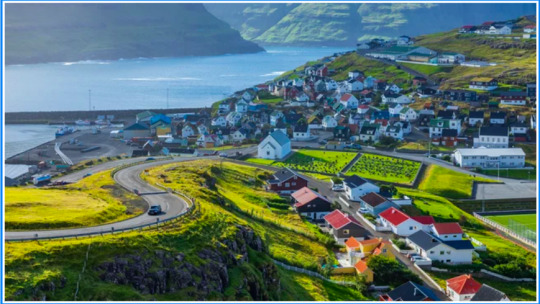
2. Bhutan: A remote Himalayan kingdom with breathtaking scenery, vibrant festivals, and a focus on Gross National Happiness.

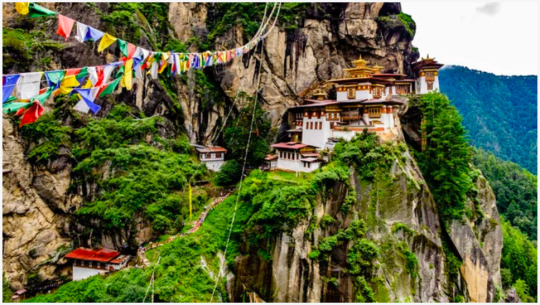
3. Azores, Portugal: A group of lush volcanic islands in the Atlantic, offering beautiful hikes, hot springs, and untouched beauty.
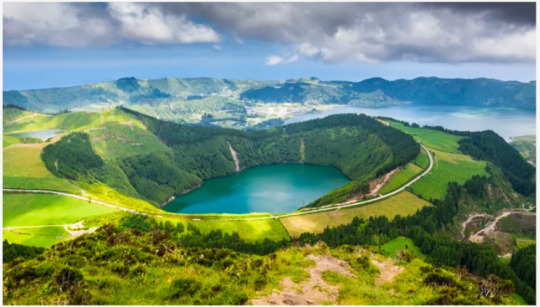
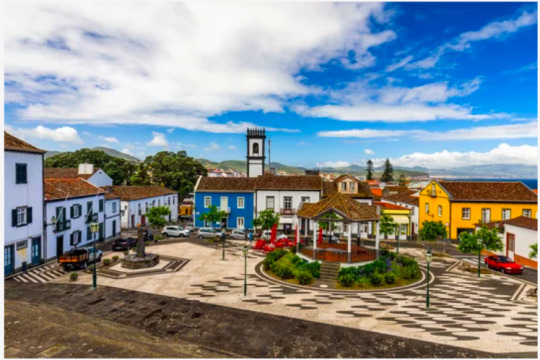
4. Svalbard, Norway: A remote Arctic destination known for its polar bear sightings, stunning glaciers, and northern lights.


5. Matera, Italy: An ancient city famous for its cave dwellings and historical architecture, often referred to as "the second Bethlehem."


6. Palau: A Pacific island nation with crystal-clear waters, diverse marine life, and some of the world's best diving spots.


7. Gobi Desert, Mongolia: A vast desert offering unique landscapes, dinosaur fossils, and the chance to experience traditional nomadic culture.

Remember that even these hidden gems may become popular over time, so it's always a good idea to plan your visit sooner rather than later if you want to experience them before they gain widespread attention.
#tourism#destination#travelling#travel#travel photography#adventure#travel blog#travel tips#places to visit#landscape#italy#norway#italia#himalayas#portugal#mountains#ocean#sea#travel destinations#travel news
21 notes
·
View notes
Text
10 Hidden places to visit in Uttarakhand
Here are 10 hidden gems in Uttarakhand that offer a unique and serene experience away from the usual tourist crowds. If you are visiting these hidden gems via Dehradun then you may also rent cars in Dehradun for your own comfort :
Kanatal: Nestled at an altitude of around 8,500 feet, Kanatal is a tranquil village with stunning views of the Himalayas. It's perfect for camping, trekking, and nature walks.
Munsiyari: Known as the 'Little Kashmir', Munsiyari is a picturesque town offering breathtaking views of the Panchachuli peaks. It's ideal for trekking, bird watching, and exploring glaciers.
Chopta: Often referred to as the 'Mini Switzerland of India', Chopta is a small region in Uttarakhand with lush meadows, dense forests, and stunning views of the Himalayas. It's also the base for the trek to Tungnath, the highest Shiva temple in the world.
Khirsu: A serene village surrounded by apple orchards and pine forests, Khirsu offers panoramic views of the snow-capped mountains. It's a perfect destination for a peaceful retreat.
Binsar: A wildlife sanctuary located at an altitude of 7,913 feet, Binsar is a haven for nature lovers and bird watchers. The Zero Point in Binsar offers a 360-degree view of the Himalayas.
Mana Village: Known as the last Indian village before the Tibet/China border, Mana is steeped in mythology and offers stunning views of the Himalayan landscape. The village is near the famous Badrinath Temple.
Peora: A small hamlet in the Kumaon region, Peora is known for its organic farming and panoramic views of the Himalayas. It's an ideal destination for those seeking solitude and nature.
Landour: A quaint cantonment town near Mussoorie, Landour is known for its colonial charm, serene environment, and stunning views of the Doon Valley. It’s less crowded than its neighbor, Mussoorie.
Abbott Mount: A hidden gem near Lohaghat, Abbott Mount offers colonial bungalows, lush green landscapes, and mesmerizing views of the Himalayan ranges. It's perfect for a peaceful vacation.
Kausani: Though not entirely hidden, Kausani is often overlooked by tourists. Known for its tea gardens and panoramic views of the Himalayas, it's a great spot for nature lovers and peace seekers.
Each of these destinations offers a unique and tranquil experience, & travelling in your on car rentals from Dehradun, away from the hustle and bustle of more popular tourist spots.
2 notes
·
View notes
Text
Mool Narayan Shikhar Temple, nestled in the serene landscapes of Bageshwar, Uttarakhand, is a hidden gem awaiting discovery by travelers seeking spiritual solace and natural beauty. This ancient temple, dedicated to Lord Shiva, sits majestically amidst lush greenery and offers breathtaking views of the surrounding Himalayan peaks. The tranquil ambiance and the spiritual aura make it a perfect destination for those looking to connect with their inner selves amidst divine tranquility. Devotees and tourists alike flock to this sacred site to seek blessings and immerse themselves in the peaceful atmosphere that permeates the temple grounds.

For travelers exploring the region, there are several places to visit near Mool Narayan Shikhar Temple that promise to enhance the journey with their unique charm and cultural significance. One such place is the historic town of Bageshwar itself, renowned for its ancient temples and vibrant local markets. Here, visitors can delve into the rich cultural heritage of Uttarakhand while savoring local delicacies and handicrafts. Just a short drive away lies the serene Bagnath Temple, dedicated to Lord Shiva and boasting intricate architecture dating back centuries.
Another captivating destination near Mool Narayan Shikhar Temple is the scenic Pindari Glacier, a trekker's paradise offering mesmerizing views of snow-capped peaks and pristine alpine meadows. Adventurers can embark on an exhilarating trek amidst nature's untouched splendor, encountering waterfalls, dense forests, and diverse wildlife along the way. Each turn on the trail reveals a new facet of Uttarakhand's natural beauty, making it an unforgettable experience for nature enthusiasts and photographers alike.
#clearholidays#Mool Narayan Shikhar Temple#places to visit near Mool Narayan Shikhar Temple#Mool Narayan Shikhar Temple tourism#Mool Narayan Shikhar Temple travel guide#Uttarakhand#india#india travel#india tourism#incredible india#Bageshwar#indian#travel#travel photography
2 notes
·
View notes